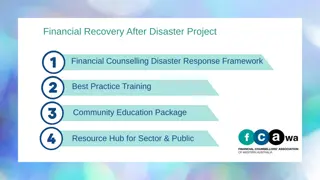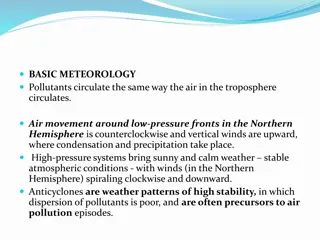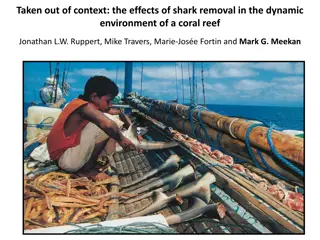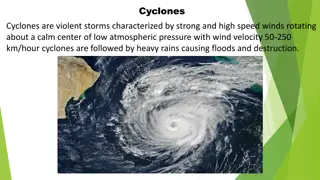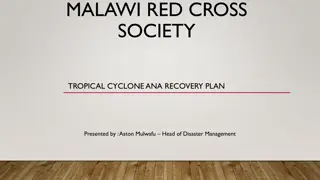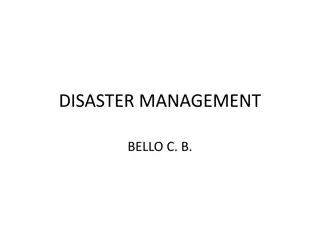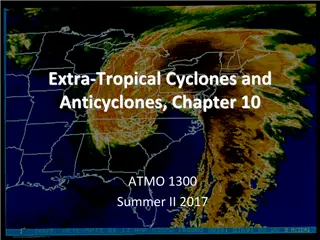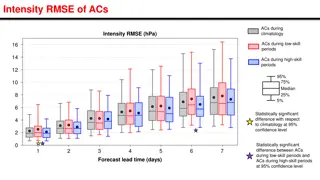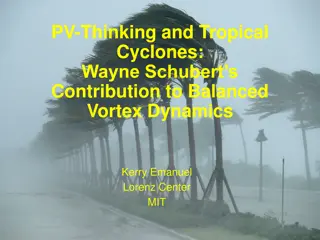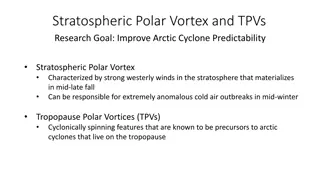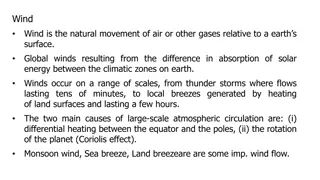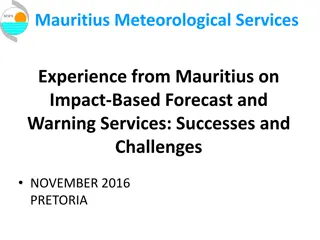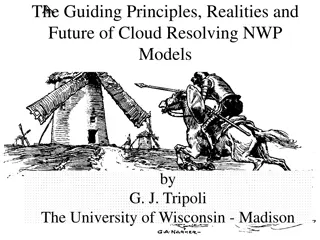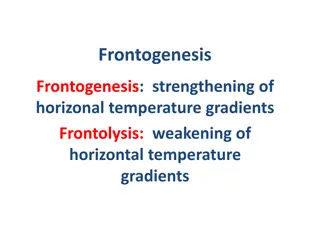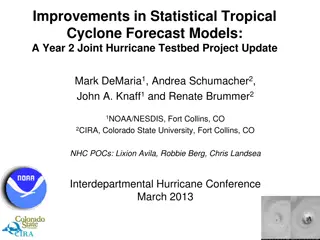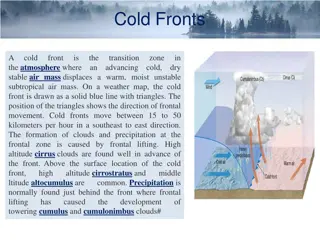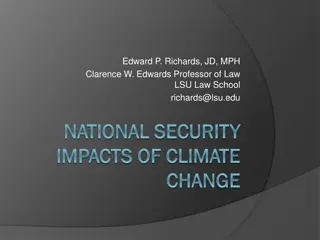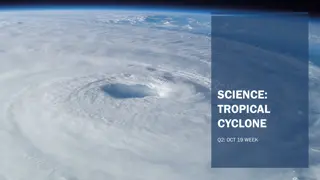Financial Recovery After Disaster Project: Comprehensive Framework for Community Resilience
This project focuses on financial recovery after disasters through financial counseling, disaster response frameworks, best practice training, and community education resources. It emphasizes understanding disaster risk governance, fostering individual responsibility, and identifying community champ
6 views • 5 slides
Richard Rotunno: A Legacy of Meteorological Excellence
Delve into the remarkable career of Richard Rotunno, spanning four decades of groundbreaking research in atmospheric science. Explore his educational background, career milestones, awards and honors, and major research contributions focusing on vortex dynamics, thunderstorms, tropical cyclones, and
2 views • 20 slides
Physical Geography of South Asia
Discover the diverse geography of South Asia, from subcontinents to archipelagos and atolls, experiencing monsoons, cyclones, storm surges, and estuaries. Explore the unique features and natural phenomena that shape this region.
3 views • 13 slides
Understanding Tropical Cyclones: General Characteristics, Types, and Origins
Tropical cyclones, developed in the region between the tropics of Capricorn and Cancer, exhibit unique characteristics such as varying size and velocity. They primarily impact coastal areas, known for low pressure centers and lack of temperature variations. These cyclones are classified based on int
0 views • 15 slides
Understanding Atmosphere Composition and Structure in Climatology
The study of climatology, focusing on the atmosphere, is presented by Dr. Banashree Saikia, covering topics such as atmospheric composition, insolation, temperature variations, atmospheric pressure, wind systems, atmospheric moisture, climatic classification, cyclones, and monsoons. The atmosphere,
1 views • 9 slides
Understanding Basic Meteorology Concepts for Air Quality Management
Pollutants circulate in the troposphere following air movement patterns around low-pressure fronts and high-pressure systems. Anticyclones and cyclones play a crucial role in atmospheric stability and pollutant dispersion. The relationship between lapse rates determines air stability and pollutant d
0 views • 24 slides
Understanding Different Types of Disasters and Their Impact
Disasters, whether natural or man-made, can cause massive disruptions leading to human suffering, economic loss, and environmental damage. Natural disasters like earthquakes and cyclones, geological disasters such as volcanic eruptions, hydrological disasters like tsunamis, and climatological disast
0 views • 11 slides
Impacts of Shark Removal on Coral Reef Dynamics
This study delves into the repercussions of shark removal on the intricate ecosystem of coral reefs. It explores the correlation between shark abundance, reef fish community structure, benthic disturbances like cyclones and bleaching, and the synergistic effects of top-down and bottom-up processes.
1 views • 18 slides
Understanding Cyclones and Tsunamis: Causes, Effects, and Management
Cyclones and tsunamis are natural disasters that can have devastating effects such as strong winds, heavy rains, floods, and destruction. Cyclones are violent storms with high-speed winds rotating around a calm center of low pressure, while tsunamis are seismic sea waves caused by earthquakes or und
0 views • 9 slides
Malawi Red Cross Society Tropical Cyclone Ana Recovery Plan Overview
Malawi Red Cross Society is responding to the impacts of multiple cyclones in the country, focusing on providing humanitarian assistance, protection support, livelihood support, and access to basic services to affected communities. Over 990,000 people urgently require assistance following damage to
4 views • 10 slides
Understanding Disaster Management: Definition, Impact, and Examples
A disaster is any occurrence causing damage, ecological disruption, or loss of life on a scale requiring an extraordinary response. This article explores the definition of disasters, their impact on communities and infrastructure, the importance of emergency response, types of hazards, vulnerability
1 views • 51 slides
Understanding Cyclones and Associated Phenomena in Disaster Management
Cyclones are large air masses characterized by swirling winds around a low-pressure center. Mesocyclones are vortexes within storms that can produce tornadoes. Dust devils and waterspouts are related phenomena, with dust devils ranging in size and potential threat levels. Other variations include st
7 views • 8 slides
Understanding Extra-Tropical Cyclones and Anticyclones
Extra-Tropical Cyclones (ETC) occur outside tropical regions and are associated with fronts, unlike hurricanes. The Norwegian Cyclone Model explains the lifecycle of ETCs, starting at the polar front and describing cyclogenesis through wind shear patterns.
2 views • 75 slides
Understanding Arctic Cyclones and Their Impact on Weather Forecasting
The Arctic environment is undergoing rapid changes, and Arctic cyclones (ACs) play a crucial role in influencing weather patterns in the region. This study explores the intensity and position root mean square error (RMSE) of ACs during different skill periods, highlighting significant differences an
0 views • 32 slides
State & Parameter Estimation for Gas-Liquid Cylone in Subsea Production
Discussing the challenges, research status, and scope of estimation for Gas-Liquid Cylindrical Cyclones in subsea production, focusing on the use of soft sensors and different estimation techniques like Unscented Kalman Filter and Linear Moving Horizon Estimator.
0 views • 16 slides
Understanding Balanced Vortex Dynamics in Tropical Cyclones
Exploring the application of Potential Vorticity (PV) thinking in understanding tropical cyclones, focusing on Wayne Schubert's contributions to balanced vortex dynamics. The discussion covers the beauty of PV-thinking in relation to baroclinic instability, the analogy between baroclinic wave dynami
0 views • 15 slides
Understanding Cyclones: Formation and Impact
Cyclones are powerful atmospheric disturbances characterized by swirling winds and heavy rainfall. They form in warm sea conditions and progress through stages of formation, maturity, and decay. Various names are used based on location. Understanding cyclone formation helps in preparing for and mana
0 views • 18 slides
Opportunities and Resources at UWFox
Discover a range of resources available at UWFox, including access to technology items through the IT Helpdesk, submission opportunities for literary and arts works with Cyclones Muse magazine, and tips on creating effective slides. Learn how to save slides as images in PowerPoint and how to request
0 views • 5 slides
Advances in Tropical Cyclone Radar Rainfall Estimation
Reviewing past methods and introducing new tools for radar rainfall estimation in tropical cyclones. Discusses advancements in Dual Polarization rainfall estimation and NSSL's National Mosaic & Multi-Sensor Quantitative Precipitation Estimation. Includes insights on reflectivity-to-rainfall relation
0 views • 28 slides
Research on Stratospheric Polar Vortex and TPVs for Arctic Cyclone Predictability
This research aims to enhance predictability of Arctic cyclones by studying the Stratospheric Polar Vortex and Tropopause Polar Vortices (TPVs). The presence of strong westerly winds in the stratosphere during fall leads to anomalous cold air outbreaks in mid-winter. TPVs serve as precursors to arct
0 views • 4 slides
Understanding Wind Patterns and Atmospheric Circulation
Wind is the natural movement of air influenced by factors like solar energy absorption, Earth's rotation, and temperature differentials. Local winds arise from small-scale convection currents due to uneven heating. Wind speed changes throughout the day based on air pressure differentials. Monsoons,
0 views • 17 slides
Impact-Based Forecasting and Warning Services in Mauritius: Successes and Challenges
The experience of the Mauritius Meteorological Services in implementing Impact-Based Forecasting and Warning Services is detailed, highlighting successes and challenges encountered in November 2016. The article discusses the main weather hazards faced by Mauritius, such as tropical cyclones, heavy r
0 views • 21 slides
Evolution and Challenges in Cloud Resolving NWP Models
Explore the evolution and challenges faced in cloud-resolving Numerical Weather Prediction (NWP) models over the past 50 years. Discover key milestones, such as the development of climate models and data assimilation systems, alongside persistent issues in predicting warm season phenomena and tropic
0 views • 45 slides
Understanding Frontogenesis and Frontolysis in Meteorology
Meteorology enthusiasts can explore the concepts of frontogenesis and frontolysis, the evolution of cyclones, and the role of the Norwegian School Meteorologists in describing fronts. Dive into the mechanisms behind the formation and weakening of horizontal temperature gradients, the interaction bet
0 views • 60 slides
Improvements in Statistical Tropical Cyclone Forecast Models Update
This update discusses improvements in statistical tropical cyclone forecast models as part of the Year 2 Joint Hurricane Testbed Project. It covers tasks such as extended range baseline models, updating databases, and trajectory approaches for baseline models. The project aims to enhance the accurac
0 views • 19 slides
Modeling Turbulent Flow in a Hydrocyclone: Example and Results
Diving into the simulation of flow in a hydrocyclone using the ?2 turbulence model, this tutorial explores the challenges of capturing swirl flow accurately for assessing separation efficiency. The model overview covers the applications of cyclones, while details on geometry, setup, mesh, solver, an
0 views • 8 slides
Understanding Cold Fronts and Occluded Fronts in Weather Systems
Cold fronts occur when advancing cold, dry air displaces warm, moist air, causing changes in temperature, winds, precipitation, and pressure. Occluded fronts result from a cold front overtaking a warm front, leading to the formation of mid-latitude cyclones. Different types of occlusions, like the c
0 views • 13 slides
National Security Impacts of Climate Change - Insights by Edward P. Richards
Edward P. Richards, JD, MPH, Clarence W. Edwards Professor of Law at LSU Law School, discusses the national security threats posed by climate change, including destabilization of political regimes, extreme weather events, and health impacts. The presentation covers key issues such as the future para
0 views • 20 slides
Understanding Tropical Cyclones and Layers of the Atmosphere
Tropical cyclones are warm-core low-pressure systems that form over oceans with high sea surface temperatures. The Philippines is prone to these cyclones, leading to heavy rains, flooding, and strong winds. The layers of the atmosphere, from the exosphere to the troposphere, play crucial roles in sh
0 views • 7 slides
